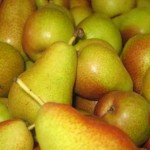Simple and super quick to make this tray bake is delicious served with warm custard.
Skills Check
Follow a recipe; follow food safety & hygiene rules; tidy away; use a sieve; crack an egg; beat an egg; cream fat and sugar; scrape out a bowl with a spatula; use measuring spoons; use weighing scales; cut using bridge/claw technique safely.
Equipment
Baking tin (20 cm square) or foil tray, weighing scales, mixing bowl, measuring spoons, electric hand whisk, small bowl, sieve, metal spoon, knife, fork, chopping board, spatula, cooling rack, oven gloves, greaseproof paper.
Allergens (Please note the allergens listed are indicative only. Allergens vary depending on brand; check the labels on the products you use)
Wheat | Gluten | Eggs | Milk
Ingredients (serves 8):
- 100g caster sugar
- 100g soft margarine
- 2 eggs
- 100g self raising flour
- 1 x 15ml spoon cocoa powder
- 1 x 5 ml spoon baking powder
- 1 pear
Method
- Preheat the oven to 180°C or Gas Mark 4.
- Grease and line the baking tin or foil tray.
- Cream the sugar and margarine together, ideally using an electric whisk until light and fluffy.
- In a small bowl, beat the eggs with a fork.
- Add the beaten egg, a little at a time, to the margarine and sugar.
- Sieve the flour and baking powder into a bowl.
- Fold the flour and baking powder into the mixture, a spoonful at a time.
- Core and chop the pear in to small pieces. Scatter pieces of pear into the lined cake tin.
- Spoon half of the plain cake mixture into the tin.
- Stir in the cocoa to the remaining cake mixture.
- Spoon the chocolate mixture into the baking tin and swirl the two mixtures together to create a marble effect.
- Place in the oven and bake for 20 minutes, until golden brown and springy to the touch.
- Remove from the oven and allow to cool.
So thinking about Marble Pear Tray Bake...

Pears are high in fibre and are packed with lots of different substances called phytochemicals. Phytochemicals can help protect our bodies against disease.
Nutritional Information
| - | Energy | 897kJ / 215kcal | 11% |
| High | Fat | 11.9g | 17% |
| Med | Saturates | 2.6g | 13% |
| High | Sugar | 13.8g | 15% |
| Med | Salt | 0.5g | 8% |
per 60g serving
% of an adult's reference intake
Typical values per 100g: Energy 1495kJ / 358kcal
Notes
A traffic light system is used on nutrition labels to make it easier to see which foods and drinks are lower in calories, fat, sugar and salt. Try and choose more ‘greens’ and ‘ambers’ and fewer ‘reds’, and stick to smaller portions of ‘reds’.
Just because a recipe or a food has a red traffic light doesn't mean you shouldn't eat it. Understanding why a food or recipe might have a red light can be helpful. For example oily fish is high in total fat and so any recipe containing oily fish is likely to be ‘red’ for fat. But it is recommended that we eat oily fish at least once a week because the type of fat it contains is beneficial for our health.
% Reference Intakes are also shown. Reference Intakes are guidelines about the approximate amount of particular nutrients and energy required for a healthy diet (based on an average-sized woman doing an average amount of physical activity). Most children will require less than these Reference Intakes. The contribution of one serving of a food or drink to the Reference Intake for each nutrient is expressed as a percentage.




